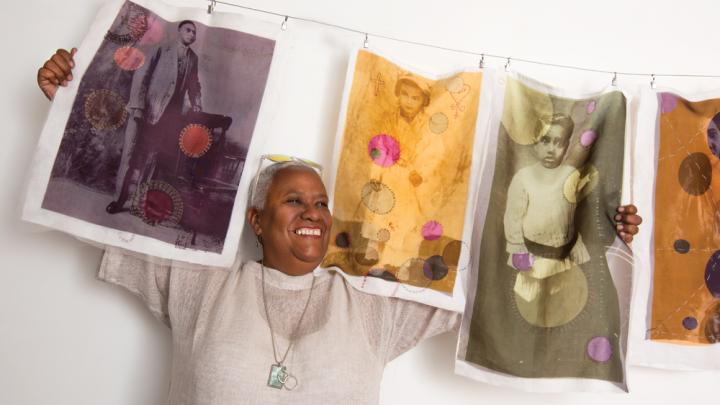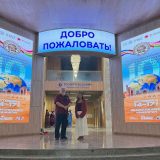
Artist Karen Hampton: Weaving the Threads of History
July 29, 2021
We are excited to announce that textile artist, educator, and mentor, Karen Hampton who investigates United States history and explores the continued legacy of slavery in America and the African Diaspora will be a special guest speaker, “Prayers for Flint” for Engaging the World: Leading the Conversation on Environmental Justice on October 29, 2021 (mark your calendars!).
Hampton grew up watching her mother and grandmother at work as seamstresses. By the age of eight years old, she had not only learned how to make all her own dolls but could make all her own clothes. While she had started experimenting with embroidery in middle school, it was in her last semester of high school that she discovered her passion for weaving in a design craft class. As Hampton’s practice continued to evolve, she quickly realized that her goal was “not to make things pretty, but to make pieces that have content.” Hampton’s work weaves her personal experiences and family stories within the larger narratives of American history, challenging viewers to realize that “history is so much more than what is before your eyes, than what you’re getting out of a textbook.”
While much of Hampton’s work captures her family history, she also creates art that addresses how the legacy of slavery continues to shape the lives of African Americans today. Prayers for Flint (2018), held by the Escallette Permanent Art Collection, is a work that memorializes the water crisis in Flint, Michigan. During a three-month residency, Hampton traveled to Flint to understand the water crisis and the emotional effect it was having on its residents. Hampton describes this work as an expression of thanks towards the people in Michigan who shared their lives and stories with her. The squares of fabric were dyed with samples of the polluted water she collected during her travels. The pairings of masks on the textile’s four corners are modeled after an African initiation mask she saw on display at the Flint Institute of Arts. She considers the mask to be “a reminder of African heritage… and [a vessel] of dreams for a better Flint.” The bottle tree in the center references the bottle trees found in the American South, mainly on African American homesteads, which are believed to trap evil spirits and protect the land. Lastly, the heart-shaped symbols represent Sankofa, a Yoruba symbol and word that means “to remember your past so you do not have to repeat it.” These symbols and representations trace the lineage of history that led to the current water crisis in Flint and offer hope, protection, and prayers for a better future.
“As an artist of color, I have made a lifelong commitment to creating artwork that responds to the lives of my ancestors. My lens is anthropology and I study my own genealogy. I travel in my ancestors’ footsteps, I walk the roads where they lived, explored the plantations where they were enslaved, I am the storyteller. As their medium I provide a vehicle for my ancestors’ spirits to transcend history and remain as historical memory. My medium is cloth — whether digitally printed, hand woven or aged linens — pieces are imbued with the hopes and visions of African American lives, telling their stories from a maternal perspective.”
Pins and Needles (2007), another Escalette piece, captures Hampton’s experience growing up in a middle-class neighborhood in Los Angeles during the Civil Rights Movement. She was one of the first group of children in California selected for a desegregation busing program. Her parents Albert Hampton (who was the president of an African American Savings and Loan Bank) and Yvonne Rowan Hampton (an accountant), formed a progressive group in 1964 called Parents for a Better Education. Partnering with a predominantly Jewish group in West Los Angeles, they created a busing program called Trans-Port to challenge Los Angeles to integrate their schools. The title “pins and needles” combined with her use of porcupine quills in the weaving capture the painful anxiety tinged with excitement that Hampton felt attending school in the affluent Bel Air neighborhood where all of the children, aside from those on her bus, were white. Affixed to the front of the textile is a photograph of the artist at six years old. She recalls how “It was the most beautiful school in Los Angeles, and I was a very lucky little girl. But I learned almost nothing about my own heritage there.”
In the early 2000s, Hampton found some long-lost family documents and rediscovered a long line of ancestors that she had never known. The stories she found have driven the focus of her art ever since. One document, in particular, recalled the life of one of Hampton’s ancestors named Flora, who was born a slave in Florida in the late 1700s. George J.F. Clarke, the son of British settlers, bought Flora and, by the early 1800s, granted her and their eight children freedom, education, and an inheritance of 33,000 acres of land. Flora’s female descendants fought racism to hold the family’s land rights well into the 20th century. Hampton describes how “the women in my family took so much battering, and they were incredibly strong. It seems like my ancestors were just waiting for me to come along, to bring them back to life.”

